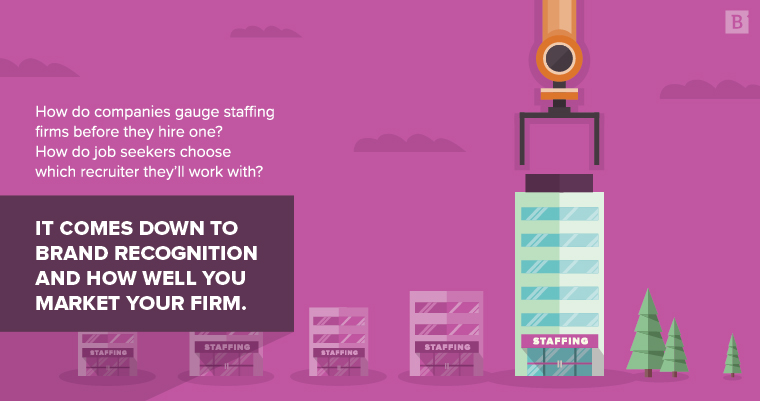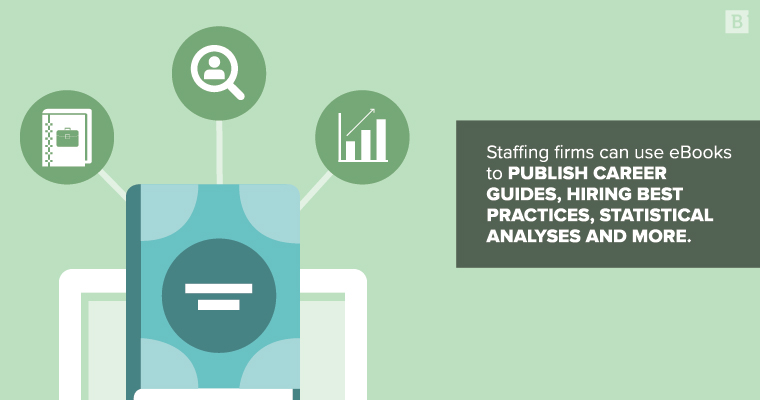Staffing agencies fill a crucial role that most people don’t fully comprehend…Until you peel back the curtain. Nearly half of all companies that use staffing agencies to hire employees do so because they want a better opportunity to gauge candidates before making a hiring decision.
But how do companies gauge staffing firms before they hire one? Likewise, how do job seekers choose which recruiter they’ll work with? Often, it comes down to brand recognition. Marketing your firm with content gives readers a glimpse into your company’s expertise and industry insight.

Develop your brand identity
Staffing agencies can generate excitement for their brands just as well as any other business. Developing a trustworthy brand is an important goal because it helps your company gain a credible reputation online, ensures the development of future business and generates value in the marketplace.
If it has been a few years since you’ve updated your brand look or voice, consider investing in new ways to freshen it up. That could mean redefining your brand’s aesthetic, developing new audience segments or taking on a whole new strategy for digital marketing.
To strengthen your brand, you need to get a clearer picture of your target audiences. Every staffing firm wants to attract top-tier talent and gain the interest of well-performing businesses, but those are highly superficial goals. By conducting market research, you’ll be able to better define niche audiences, understand what kind of content appeals to them and direct them along a satisfying career trajectory. Utilizing site analytics will tell you which pages hold the most interest for current visitors, and surveys can help you define new topics for future content.
Craft a unique mission statement and value proposition
To stand out in a crowded marketplace, you need to have a thorough understanding of the competition. That doesn’t mean just knowing who your competitors are but rather knowing what they can offer that you cannot. Armed with this information, make a game plan. Will you squeeze into an unfilled niche? Or will you conquer another agency’s territory?
Those are tough questions to answer, but it becomes easier to do so when you have clear, transparent market research on your side. From there, you can define your value proposition and define how you will position your company against competitors. Remember, when a prospect conducts an online search, he or she won’t see your brand in a vacuum but rather starkly contrasted against your competitors. If your company can’t compete at this initial stage, it’s time to redefine your value proposition.
When you have a better understanding of where your company stands in the market, let your target readers know. That’s where a clearly worded mission statement comes into play.
A useful mission statement not only explains the goals of the company but also defines what the business values on a social level. Recent research shows that 64 percent of consumers have relationships with brands because they share values with those brands.
Create content that’s relevant to job seekers
When you understand what your target audience values, it’s easier to develop content that appeals to them. To create highly targeted content, think like your audience.
Staffing firms typically split their audiences into two groups: job seekers and employers. Each segment has drastically different needs, but the solution to either problem is the same: getting a talented individual into a position that suits his or her skills, passions and experiences.
How does content help fulfill this need? By positioning your brand as a leader, innovator, resource or all of the above.
This is different from traditional advertising because it helps the reader solve a problem before they’ve fully engaged with your brand. Plus, content marketing is 62 percent more affordable than traditional advertising and generates three times the leads.
Consider this scenario: A job seeker wants to know how to format his resume, so he conducts a search for the phrase “best resume format” and finds an article on your site explaining best practices. This brief, automated interaction instantly creates a positive experience and is the first step toward developing brand trust. Compare that scenario to a traditional advertisement – the ad may improve your brand recognition, but it probably won’t help to develop a positive relationship with readers.
Let’s look at few types of content and how staffing agencies can leverage each to the greatest advantage:
- Blog articles: Your company blog is a tool that can help you build brand perception, attract new followers and generate leads. How-to articles are ideally suited for developing thought leadership within the industry. Consider segmenting your blog into categories aimed at job seekers and employers.
- White papers: A longer, well-researched document such as a white paper is the perfect format for B2B marketing. It’s a great platform for demonstrating your business’s value proposition. Placing a white paper behind a form is an effective way to generate leads and grow your mailing list. If you use an ATS to aggregate job applicants, you could easily pull out various statistics and patterns from the thousands of applications you process, and then publish a white paper on a relevant subject.
- eBooks: Targeted content works best when it’s easy to digest, and the combination of slick imagery and relevant data makes eBooks very easy to consume. Staffing firms can use the eBook format to publish career guides, hiring best practices, statistical analyses and more. Plus, eBooks are just as easy to consume on mobile as on desktop.
- Infographics: A highly shareable asset, infographics are well-suited for strategically deploying statistical information. Staffing firms can use visual assets to quickly explain hiring trends, delve into cost analyses and share job search tips with relevant readers. Brand colors and custom visuals make infographics a great way to show off your company’s style.
- Videos: Video is a fantastic way to build your agency’s brand and connect with your target audiences on a deeper level. Videos put a face to a name, and that can help boost brand loyalty. You can also repurpose blog articles and infographics into short videos. The majority of videos published online are shorter than two minutes.

Every time you develop a new piece of content, you’ll need to align it with your brand’s core values, ensuring it speaks to the right niche audience and uses the correct language to get noticed online. Though your content may live on your company’s website, you should expand its reach using social media networks.
Use social media to reach new audience segments
When we want information, we turn to the internet. Job seekers are no different.
When they want to find a new opportunity or advance their career, job seekers rely on the web. Job and employment websites, like Jooble, and social media platforms, like Linkedin, play an important role in this process. Networking has always been one of the best ways to land a job, and now social networks make it easier for professionals to connect with one another.
Social media is where people go to research and apply for jobs, so staffing agencies need to have a social media presence or risk getting left out in the cold. According to Glassdoor, 86 percent of people in their first decade of employment use social media to find new opportunities. So you know your business needs to be visible on social media, but which network is the right fit?
LinkedIn is perhaps the most obvious choice. Acting as a living resume, the network helps job seekers get noticed and connect with potential employers. Businesses also maintain a presence on the site to filter potential employees during the hiring process. Posting your content to LinkedIn is a great way to get it in front of a wider audience.
Your agency can leverage unique social media channels for different facets of your brand.
- Facebook is great for highlighting your customer service, displaying case studies and promoting lifestyle articles.
- Instagram and Pinterest are visual platforms great for sharing infographic snippets, custom illustrations, humorous memes and more.
- YouTube is perfect for curating a channel of helpful videos, from five-minute Q&A sessions to 30-minute deep dives into specific topics.
Whichever social media platforms you choose, be consistent with your branding and with how often you post. Sporadic posts with long periods of silence in between give the impression that your brand is half-heartedly committed to public outreach. Your readers expect a steady stream of content.
Developing a social media strategy, content schedule and brand identity all at once is a monumental task. Consider auditing your staffing agency’s marketing strategy and goals to determine which aspect you should focus on first.
Sources:
- https://www.demandmetric.com/content/content-marketing-infographic
- https://hbr.org/2012/05/three-myths-about-customer-eng
- https://www.vidyard.com/blog/16-video-benchmarks-need-to-know-infographic/
- https://americanstaffing.net/staffing-research-data/fact-sheets-analysis-staffing-industry-trends/
- https://d2m21dzi54s7kp.cloudfront.net/wp-content/uploads/2015/04/ASA-fact-sheet_reasons-to-use-staffing-firms_april-2015.pdf
- https://b2b-assets.glassdoor.com/50-hr-and-recruiting-stats.pdf
- https://www.brafton.com/blog/social-media/social-media-marketing-for-staffing-firms-6-companies-that-do-it-well/





